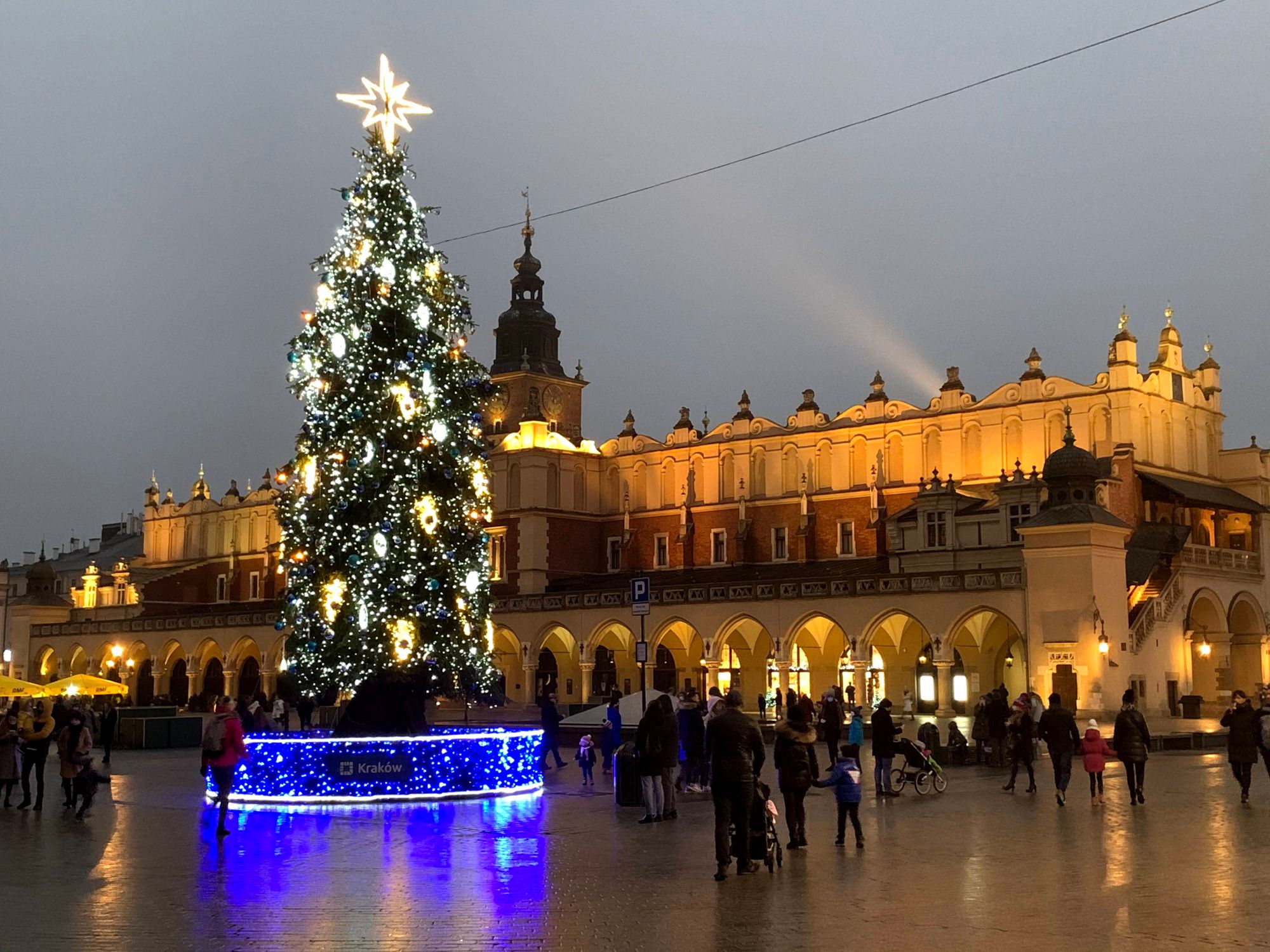Kraków used to be the seat of Poland's kings. It is a city rich in history. Therefore, important events took place there and important people lived in the city. There are also numerous not-so-historical stories and legends. A friend of mine, who runs BudgetBucketList blog has asked me to write some stories and legends from Kraków. As an history-freak, I am more than happy to oblige!

The Broken Tune
The church shown above is XIII century basilica, located in the Main Square. Everyone visiting Kraków would visit the square and would see the church. And almost everyone would hear two stories connected with the church.
At every top of an hour, 24 times per day, a trumpet call is played from the higher of the church's towers. A tune is a tune, but this one ends abruptly. It commemorates an unknown watchmen from XIII century who ran up to the top of the tower and started to play a call, to warn citizens of approaching Tartars (Mongols, actually). As he played, the Tartars, experts in bow shooting from horses, released a volley of arrows and one pierced the watchman's throat, ending the signal. But enough had been played and the city defenders had been alerted.
The trumpet call is played by a fireman. Part of their job description, they have to scale 300 stairs (80 meters) every hour to play the tune. They play it four time, to the four parts of the world. They are on 12hrs duty and so every work day means going up 12 times and playing the tune 48 times!
The Two Towers
You may notice that the church's towers are not equal in height. No building plans have been preserved, so it puzzles historians. However, a legend has an explanation. As it goes, the towers were constructed by two brothers. When the younger saw that his older brother's tower had risen above his, he killed his bro. But then, shaken by remorse, he took his own life with a knife. The knife is displayed in Sukiennice (Cloth Hall) - the long building located at the center of the Main Square.

The Dragon
A set of legends wouldn't be really complete without a dragon. So stories and legends from Kraków do include one. Once upon the time, a dragon lived in a cave under the Wawel hill. As dragons do, he had a taste for girls... Well, he ate them. The city had to provide one each month. As time passed by, it was the king's daughter turn. The king, desperate to save his only child, offered a high reward to anyone who would get rid of the dragon. Many a valiant knights tried and failed. Finally, a shoemaker's apprentice, Szewczyk Dratewka, came up with a ruse. He filled a sheep's skin with tar and sulfur and left it at the dragon's cave. The dragon ate it and became so thirsty that started to drink water from the Vistula river by the gallons. He drank, drank and drunk until his belly burst. The king was grateful and gave the apprentice his daughter's hand in marriage. Then they ruled long and happy... So the legend goes.

Sex that Wasn't
The Wawel hill is where the Royal Castle is. Built on a high cliff above the Vistula (Wisła) river, it dominates the city below. There were many sieges, coronations, diplomatic negotiations and royal weddings and funerals. I am going to tell a story, which is not found in the history books, but is true nevertheless.
In the XIV century Polish first ruling dynasty, the Piasts, have died out. At least in royal line. In the lack of a better candidate, the king of Hungary, was chosen. He was nephew to the last Piast king, so he offered some continuity. When he died however, he didn't leave any son. So his daughters were chosen to rule, one in Hungary, the other - Jadwiga - in Poland. Jadwiga was at that time 10 years old. As a side note, she was crowned Rex Poloniae - king of Poland. She was accepted by the nobility who thought it would be easy to control a 10 years old girl on the throne. There was however a problem. When she had been 4 years old, she had been married to William Habsburg of Austria. Such marriages were common among ruling elites of the Middle Ages. Of course no one expected children to be really married. It was a promise, a contract if you will. Such contracts were usually made valid only where the children grew into teenagers and were able to consume the union (plainly speaking - their first sex made the marriage valid). So when our Jadwiga was old enough (which meant then about 12-13 years old...), the king of Austria sent his son, then 16, to Kraków. From Austrian point of view, that could mean that Poland would become a dominion of the Habsburgs. The Polish nobility didn't like that idea so they chased off the young William. They also made sure that Jadwiga was well guarded at all times. There's a legend that young Jadwiga was so desperate to meet William that she took an axe and tried to break free from her rooms. Legend aside, the fact is that they had not met and their marriage was declared null and void. Jadwiga would later marry a duke of Lithuania, Władysław Jagiełło, who was more acceptable for the Polish nobility.
Had the young couple managed to have sex, Polish history would have taken a completely different turn. It was one of those moments that decide the fate of nations.
An Overheard Discussion
Speaking of chance moments, there is another true history. This time the scope is much smaller. Let me first show a picture of an interesting monument found in Kraków, near the Wawel hill.

The figures on the bench are Stefan Banach and Otto Nikodym. The former would become the greatest Polish mathematician, the father of modern functional analysis.
Stefan Banach was bastard son in a poor family. His mother was not interested in raising him up, so he grew at his grandmother's. Early on he showed math skills, but a high school in Kraków was all that his family could afford. After graduation he was supposed to get some job. But then fate or chance came in. Sitting on a bench in a park, Stefan Banach discussed Lebesque integration (ever heard of it?...). It's apparently a very complex mathematical problem. Passing nearby, was profesor Hugo Steinhaus, a renowned mathematician of the time. He overheard the young men's discussion and joined in. Astonished by Stefan Banach's sharp brains and unexpected knowledge from a self-taught youngster, prof. Steinhaus invited the duo to work with him. He promoted Banach's career and later on allegedly stated that Stefan Banach had been his greatest mathematical discovery.
Up Close and Personal
There are so many stories and legends from Kraków, that one would need a book to tell them all. Let me leave you with those cited above. Actually, I have one more, which no city guide will tell you.

The church above has figures of the Twelve Apostles at its front gate. Years ago, I went with my high school class to Kraków. As we walked down the street, one of my colleagues climbed up and stood on the unoccupied postument that you can see at the left-hand site of the above picture. A photo was taken and so Michał became the Thirteenth Apostle :-) The event and the photo were dully archived in my high school's chronicle.




